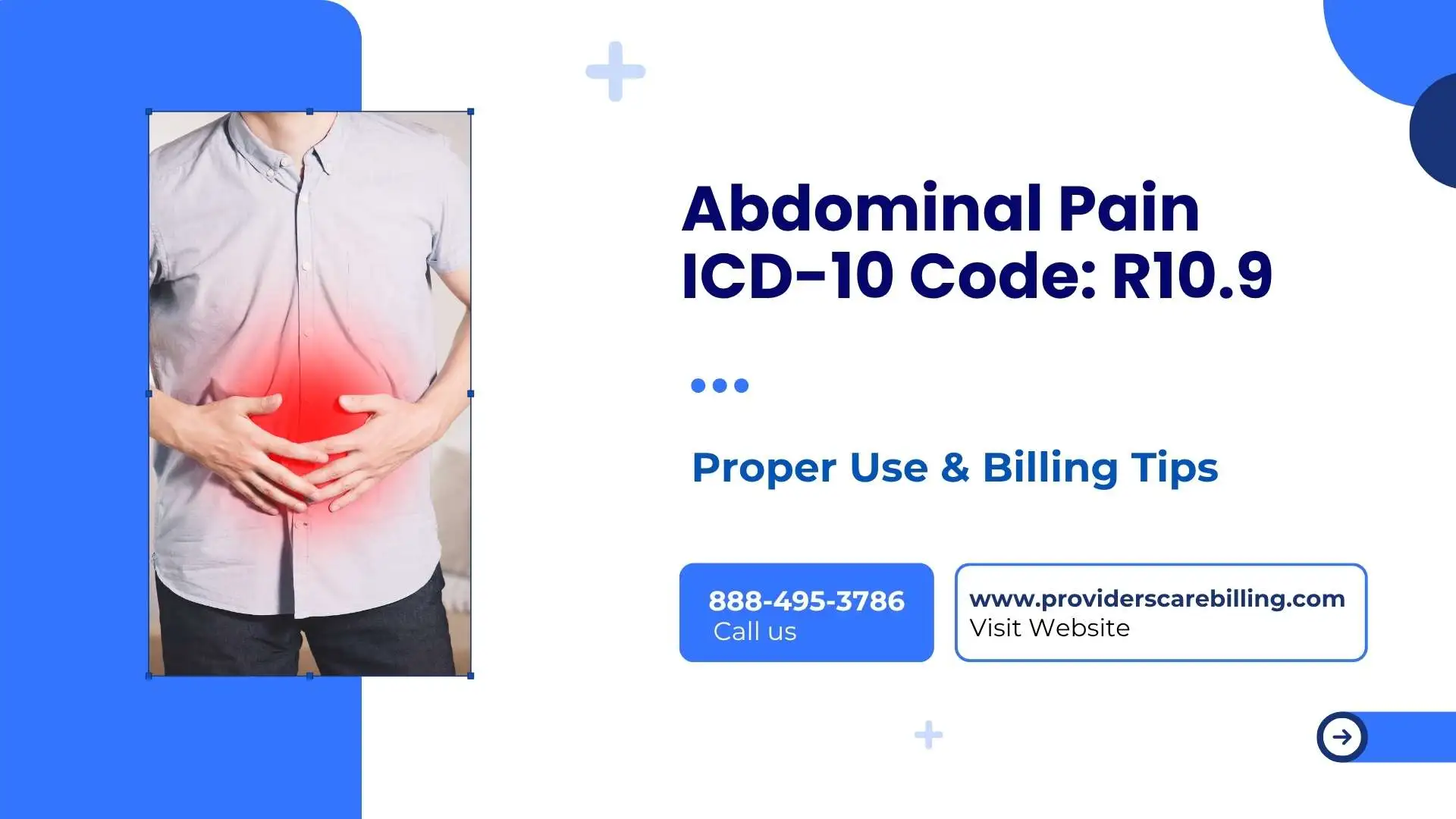Abdominal pain is the chief complaint in one of the 10 most frequent diagnoses in emergency rooms (ERs) across the country and one of the top chronic and acute problems treated in ERs and outpatient clinics of the 21st century. Correctly coding and documenting it with ICD-10 codes such as R10.9 for unspecified cases is critical for medical coders and providers, for billing, reimbursement, and care planning purposes. But there is so much variation across abdominal pain, it can be hard to pick the best ICD-10 code for abdominal pain.
Enter this resource – it demystifies some of the key ICD-10 abdominal pain codes so you can get rid of the misinformation you might run into while coding this wide-ranging, yet common, symptom.
Whether you confront ordinary aches or pain in one of the quadrants, the ability to decipher these codes will improve your coding accuracy and your reimbursement.
The fundamentals of ICD-10 coding explained
For diagnosis and coding of medical conditions, the ICD-10 is the worldwide standard. Coding and billing these codes is crucial for:
- Healthcare billing accuracy – Proper submission and processing of claims
- Insurance payment facilitation – Making it easier for you to get paid.
- Data analysis – Development of population health studies and clinical research
- Quality reporting–compliance with regulations and performance indicators
The precision of ICD-10 codes very much impacts the profitability of practices in that they determine reimbursement and coverage. Ambiguity or errors in coding may result in denials, delayed payments, and compliance problems. Abdominal Pain – The difficulty with abdominal pain in particular is how to identify the specific location and severity, as well as the symptoms associated, so that the appropriate code is selected.
R10.9: Unspecified Abdominal Pain
R10.9 is the broadest classification for the documentation of ICD-10 codes for abdominal pain. Use this code if:
- There is no specific location where it occurs in the body.
- No detailed information about the pain properties from clinical documentation
- Can’t be more specific based on the initial evaluation
But excessive use of unspecified codes may affect reimbursement, and does not offer valuable clinical information for patient care analysis.
R10.84: Generalized Abdominal Pain
This abdominal pain ICD-10 code is used when a patient has pain in the abdomen diffusely without focal localization. It is often used for diseases such as gastroenteritis or early appendicitis, or, before localization, inflammatory diseases.
R10.30: Lower Abdominal Pain, Unspecified
R10.30 is pain in the lower abdomen when the quadrant is not established. This code often applies to:
- Urinary tract infections
- Reproductive system disorders
- Lower gastrointestinal conditions
R10.11: Right Upper Quadrant Pain
This type of ICD for belly ache focuses on the right upper side and generally corresponds to:
- Gallbladder conditions
- Liver disorders
- Right-sided kidney problems
R10.31: Right Lower Quadrant Pain
R10.31 focuses on pain in the right lower quadrant, most commonly related to:
- Appendicitis
- Ovarian conditions
- Cecal disorders
R10.13: Epigastric Pain
The epigastric pain code describes a pain centered in the upper middle part of the abdomen and includes pain due to:
- Gastric ulcers
- Pancreatitis
- Gastroesophageal reflux disease
ICD-10 Codes with Abdominal Pain with Further Specification
Abdominal Tenderness
The ICD-10 code for abdominal tenderness needs to be specific with regard to severity and site. Tenderness implies inflammation or infection and should be noted with precise quadrant involvement if possible.
Abdominal Cramping
In coding for cramping, the ICD-10 code for abdominal cramping should indicate the episodic or recurrent nature of this symptom. Symptoms such as diarrhea or constipation may require additional codes for accurate reporting.
Abdominal Discomfort
The ICD-10 code for abdominal pain is distinct from codes for acute pain, as it is a milder, chronic feeling. This distinction is clinically relevant in order to represent adequately and plan treatment.
Real-Life Coding Scenario
Consider Sarah, a 35-year-old patient who arrives in the emergency department complaining of severe pain in her lower right abdomen, nausea, and a low-grade fever. Since 8 hours have passed, the pain has continued to worsen.
Coding Process:
- Commence A71-year-old female with right-sided lower abdominal pain R10. 31
- Fever and nausea are also associated with appendicitis. Chart review – Physician notes that there is tenderness over the local area.
- Final code selection R10.3131 (RLQ pain) with other codes for nausea and fever
This case illustrates the importance of detailed location coding for clinical care as well as for billing considerations.
Ready to Simplify Your Medical Coding Processing? Up-to-date Coding Services for Accuracy and Maximum Reimbursement by Providers Care Billing LLC.
ICD-10 Coding for Abdominal Pain: How to Capture Your Patient’s Pain Right the First Time
Documentation Best Practices
- Site specific – Be sure to record the specific quadrant or location
- Pattern of pain – The intensity, duration, and quality of pain
- Accompanying symptoms – Observe if the dog is experiencing any added symptoms such as vomiting, nausea, or fever.
- Timing – Report onset of document, progress, symptoms, and exacerbating factors
Coding Guidelines
- Ask Providers where the documentation is not specific
- Avoid using non-specific codes when specific codes are available
- Keep current on ICD-10 coding guideline revisions each year
- Utilize a combination code when codes are required to describe more complex presentations
If the patient also has diabetes-related nerve issues, you can refer to our guide on diabetic neuropathy coding for proper use of E11.40 and E11.42.
Common Coding Errors to Avoid
- Code ICD-10 codes for abdominal pain, unspecified when the site is known
- Disregarding other symptoms that would need supplementary codes
- Not aiming to represent bilateral or multiple locations of pain adequately
Frequently Asked Questions
Q: When should I use R10? 9 versus more specific codes?
A: Use R10.9 only when the specifications do not address location specificity. Whenever available, more specific codes should be used based on available clinical information.
Q: Are we allowed to bill for the abdominal pain using more than 1 abdominal pain code for the same patient?
A: Yes, if the patient reports pain in multiple specific areas or multiple types of abdominal pain.
Q: How is coding tied to reimbursement?
A: It is generally more beneficial for reimbursement purposes and less likely to have claims denied to use specific rather than unspecified codes.
Correct coding of ICD-10 abdominal pain involves attention to detail, complete review of documentation, and keeping abreast of coding guidelines. The difference between using R10.9 and more detailed ones ,such as R10.31, can have a significant impact on both the quality of patient care and reimbursement results.
Keep in mind that good code has a few different uses: for patient care, billing, and for data. By using the tips and cases provided in this guide, you have what it takes to better manage your abdominal pain coding.
Ready to streamline your medical billing and coding workflows? Provider’s Care Billing, LLC – Offers high-end Medical Billing & Coding Services, at just 2.89%. With a history of delivering quality results, the business is proud to have received 100% client satisfaction and an amazing 4.9-star rating. Call us today to learn how our skilled staff can improve your practice’s revenue cycle management and coding accuracy.




